If you have ever set foot in Saigon city, you will surely be overwhelmed by the atmosphere that is always bustling and crowded, whether at night or during the day. District 1 is considered the “mecca” of the main places to hang out, so if you are a first-time visitor to Saigon, definitely book yourself a room in District 1 to be able to explore all the attractions.
Table of Contents
Top 6 most famous places to visit in District 1, HCMC
Independence Palace
Independence Palace, also known as Reunification Palace, is located in the heart of Ho Chi Minh City, at 135 Nam Ky Khoi Nghia, Ben Nghe Ward, District 1. This address is also close to other attractive tourist attractions such as Notre Dame Cathedral, April 30 Park, Central Post Office…With its location in the city center, the means of transportation to the Independence Palace is also quite diverse: bus, taxi, car, and motorbike.
Independence Palace has a floor area of up to 120,000m2 located in the downtown area of Ho Chi Minh City, limited by four main streets, namely Nam Ky Khoi Nghia in the Northeast, and Nguyen Thi Minh Khai in the East. Northwest, Huyen Tran Cong Chua Street to the southwest, and Nguyen Du to the southeast. In addition, on the grounds of the palace, there are many ancient trees with different species planted since the French colonial period.
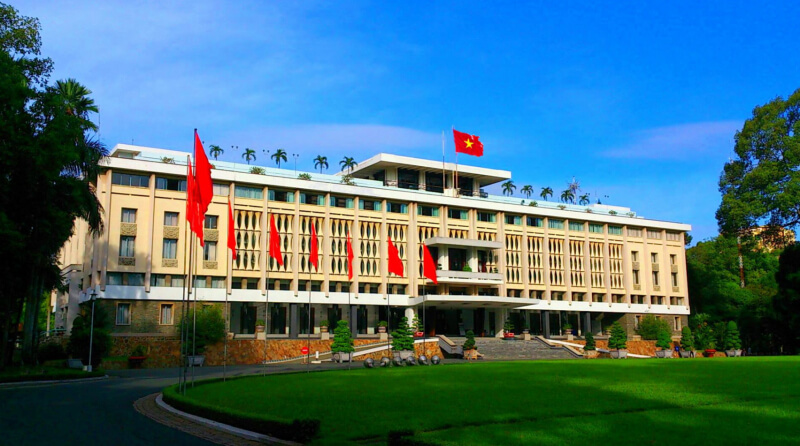
Independence Palace is designed based on feng shui as well as oriental architecture but still has modern features. Coming to the Independence Palace, visitors will be free to learn through the system of panels, signboards… according to international standards. If you need an interpreter, you can hire a group. After visiting the Palace, you will watch the 25-minute documentary film “Independence Palace – historical witness” in the cinema room.
Special interior architecture system:
State Room: This is the first point when visiting the Independence Palace. The stateroom has a capacity of 500 people, which is used to organize meetings, receptions, and cabinet launching ceremonies.
Residence of the President’s family: Another interesting attraction to mention here is the residence of the President’s family. The person with the longest life is the President under the old regime Nguyen Van Thieu (from October 1967 to April 21, 1975).
Credentials presentation room on the 1st floor with the painting “Binh Ngo Dai Cao” consisting of 40 pieces that describe the peaceful life of Vietnamese people in the 15th century.
Basement: The basement is full of communication rooms, printing rooms…. Ensure the distribution of the President’s orders to the outside (collection of photos).
Historical artifacts: On the roof of the Independence Palace, there is a display of President Nguyen Van Thieu’s UH-1 helicopter, next to the location of two bombs that pilot Nguyen Thanh Trung threw and exploded. The Mercedes Benz 200 W110 with German license plate VN-13-78 is one of the cars that President Nguyen Van Thieu used to drive. The Jeep M152A2 was used by the Liberation Revolutionary Forces to carry Mr. Duong Van Minh, the last President of the Republic of Vietnam, to the Saigon radio station to read the declaration of surrender at noon on April 30, 1975. Thanks to the historical elements of artifacts such as 390 tanks, 843 tanks, and F5E fighter aircraft, it has contributed to making the Reunification Palace become a more attractive tourist destination in the hearts of tourists.
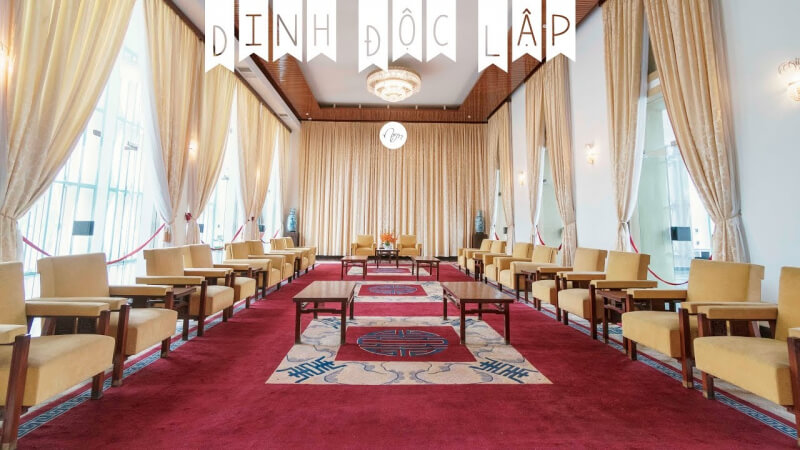
Valuable works of art: In addition, when visiting the Independence Palace, you can also admire many valuable works of art: An oil painting depicting the countryside scene of Vietnam’s country Architect Ngo Viet Thu. The oil painting shows the scene where sisters Thuy Kieu and Thuy Van meet Kim Trong on the day of the Qingming New Year. And dozens of ancient Chinese ceramic vases of the Ming-Qing dynasties are also decorated here.
Opening hours, ticket prices:
Morning from 7:30 – 11:00, and afternoon from 13:00 – 16:00 on weekdays.
Ticket price: For adults is 40,000 VND; 20,000 VND for students, and 10,000 ND students from 6 to 17 years old. If you are in a group of 20 people, you will get a third of the ticket price.
- Address: No. 135 Nam Ky Khoi Nghia Street, District 1, City. Ho Chi Minh
- Website: https://dinhdoclap.gov.vn
Ben Thanh Market
If the Dong Xuan market is the cultural feature of Hanoi, then the Ben Thanh market is one of the unique features of Saigon that everyone will remember first. It will really be a big regret when you come here that you miss Ben Thanh market.
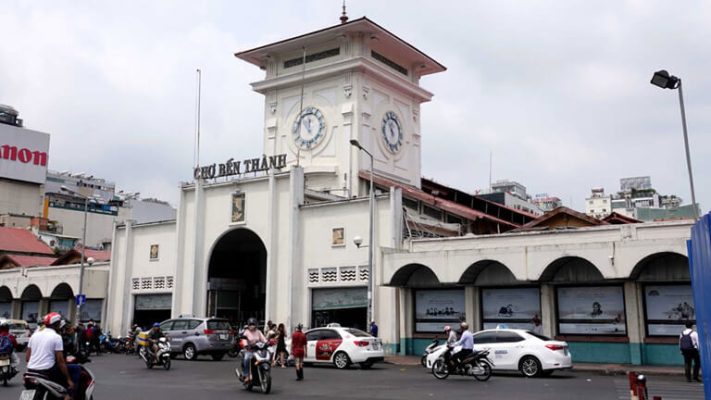
Ben Thanh Market is located in Cua Nam – the intersection between Phan Boi Chau, Phan Chu Trinh, Le Thanh Ton streets, and Quach Thi Trang Square, Ben Nghe Ward, District 1, and is the oldest market here. The most prominent symbol of the market is the image of the clock at the south door of the market like Big Ben in London.
The market has a history dating back to the early 17th century, at that time the market was located near the Saigon River and was a place for small businesses to buy and sell. During the resistance war against the French, the market was located on the banks of the Ben Nghe River, this wharf was used to serve visitors and soldiers entering the citadel. Therefore, the market is called Ben Thanh Market.
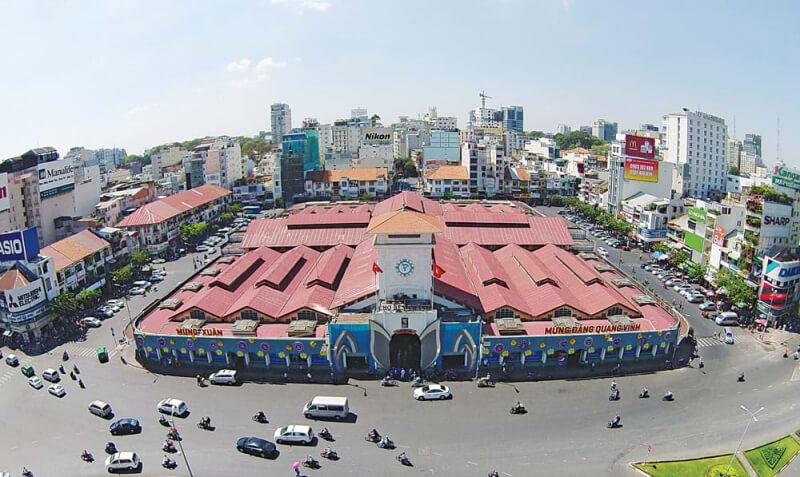
With an area of over 13,000m2, the market sells mainly clothes, fabrics, shoes, fashion, handicrafts, fresh food, fresh fruits, and flowers. In addition, the market is also very rich with snack shops and regional dishes in the South.
Weaving between the stalls, visitors will surely be overwhelmed with the variety of items here. You can easily find your favorite items from small souvenirs such as necklaces, earrings, wallets, scarves, etc. to traditional costumes or school bags, etc. Not forgetting to mention the diverse cuisine. variety and variety of Ben Thanh market.
Saigon tea is certainly no stranger to people in all regions, coming to the market, you will be overwhelmed with a long line of tea stalls of all colors from the green of the nuggets, the yellow of bananas, corn, the white of the tea. Coconut milk, purple color of taro, red color of pomegranate seeds, etc. And especially, at Gate 7 there is a tea shop with more than 40 years of experience specializing in Southern tea dishes.
The main dishes must include broken rice, rib rice, vermicelli, spring rolls, grilled meat vermicelli, and seven-color sticky rice. Snacks are plentiful such as mixed rice paper, Hue cake, snail dishes, flour cake, and “Brilliant – Bustling” is what can be seen at Ben Thanh market when the moon rises. It seems that this is the “real life” time of this market. Many trade activities and many tourists and locals visit, enjoy the food, ready to live with a “second Saigon” – Saigon at night.
If mentioning Saigon is referring to the bustle and fast living, it is necessary to feel and understand better that: the fast of the day is work, the worries of life, and the speed of the night are the color of the city. parties.
- Address: Market, Le Loi, Ben Thanh Ward, District 1, Ho Chi Minh City
- Phone: 028 3829 9274
Notre-Dame Cathedral Basilica of Saigon
Ho Chi Minh City is famous as a dynamic and colorful city with many entertainment spots. If you have the opportunity to visit Saigon, you will not be able to ignore Notre Dame Cathedral – one of the most special architectural sites of the city named after Uncle Ho.
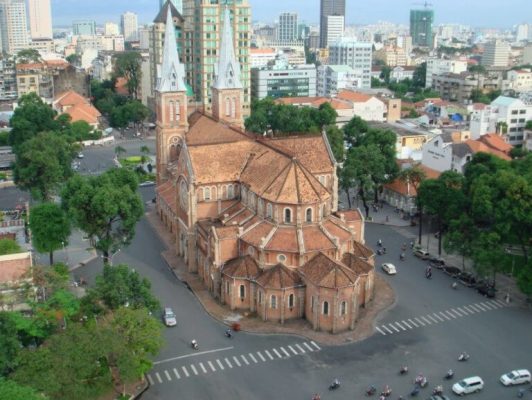
Immediately after capturing Saigon in 1859, the French rushed to establish a church to serve as a place to celebrate Mass for Catholics. After many conversions and renovations, Admiral Cochinchina Duperre held a competition to draw design plans for the new church. Overcoming dozens of other design projects, the project of architect J. Bourard was selected with a bold Roman architectural style mixed with Gothic art. After the project was selected, the church was officially started in 1877 and it was architect J. Bourard who directly supervised the construction. All construction materials such as cement, iron, steel, etc. are brought from France. After 3 years, the project was completed and put into use and cost about 2,500,000 French francs at the exchange rate at that time.
Notre Dame Cathedral Basilica is located right in the city center at address 1, Cong Xa Paris, Ben Nghe Ward, District 1, Ho Chi Minh City. Today, Notre Dame Cathedral is one of the most unique architectural works in Saigon, not only attracting the attention of millions of domestic and foreign tourists to visit and attend Mass but also the place to visit. gathering of dynamic young people.
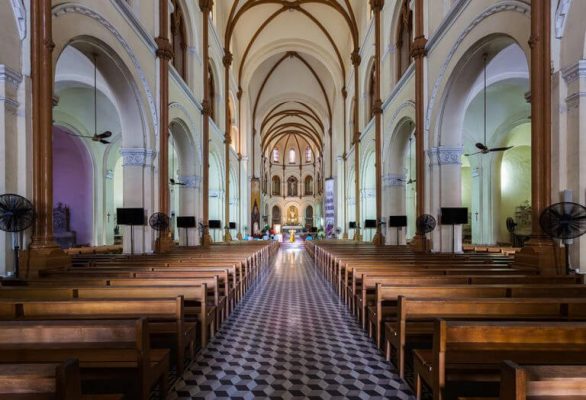
After 130 years of political and historical upheaval, Notre Dame Cathedral still stands there, seemingly unaffected by time. The cathedral has a circumference of 91 x 35.5 m, a height of 21 m, and a rather special work in the middle of the square, without a fence and separating campus, Notre Dame is really a highlight in the urban space.
At first, there were no sharp peaks on the two bell towers, in 1894 they were added according to the plan of architect Gardes, two 57m high bell towers. In 1920, on each side of the bell tower, a cross was placed 3.5m high and 2m wide. The total height of the church from the ground to the top is 60.5m. The bell tower has 6 bells with a total weight of 25,850kg, the heaviest in Indochina at that time.
The interior of the cathedral is designed into one main heart, two sub-beds, followed by two rows of chapels. The cathedral has a capacity of about 1,200 people, with two main rectangular columns consisting of a total of 12 representing the 12 apostles. Behind the main columns is a corridor with compartments for more than 20 altars with small saints made of delicate white stone. The lighting system of the cathedral is designed with electricity. During the day, it is illuminated by sunlight, through stained glass windows and ventilation holes.
The architecture of the cathedral has created a wonderful light effect in the interior giving a feeling of stillness and solemnity. The fanciful light also makes the architectural details and the interior of the cathedral more prominent and fanciful.
The park in front of the citadel has a statue of Our Lady of Peace carved in Italy, moved to Saigon in 1959 by waterway. The statue is 4.6 m high, weighs 5.8 tons, of white marble, is unpolished, and still retains its primitive appearance. The unique architecture and rare antiques are enough for Saigon Notre Dame Cathedral to become an indispensable destination for tourists near and far. Notre Dame Cathedral is truly a European-style architectural work, a “peaceful corner” in the heart of Saigon.
- Address: 01 Paris Commune, Ben Nghe, District 1, Ho Chi Minh City
- Opening hours: 6.00 – 20.00
Nguyen Hue Walking Street
Nguyen Hue pedestrian street has long become an attractive destination not only for tourists but also for locals in Saigon. Besides the main street, around this street, there are also many interesting things that you may not know. This lively pedestrian street is located on Nguyen Hue Street, in District 1, Ho Chi Minh City, extending from the headquarters of the City People’s Committee to Bach Dang Wharf.
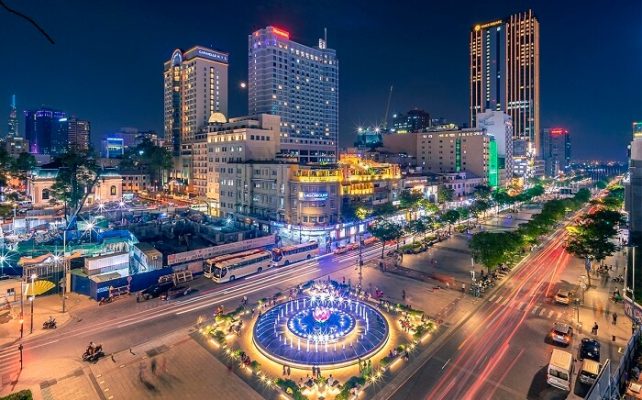
Since its inauguration until now, this has always been one of the busiest entertainment destinations in Saigon because of its open space, many interesting and useful activities as well as beautiful apartment buildings, and shops. Bustling restaurants and cafes
Nguyen Hue Street is likened by many people to a certain overseas street, with no electricity, no garbage, and a neat street with lanes reserved for pedestrians everywhere. The long road is paved with clean granite with 2 fountains, and a system of trees and flowers is decorated vividly. In the evening, the lights here as well as the lights from the eateries, restaurants, and cafes shine, creating beautiful moments. Therefore, for those of you who are passionate about photography, and like to have really shimmering photos, just come out here to have all the necessary context.
Large yards are the place for smart 2-wheelers or exciting roller-skating, attracting children to young people. In the evenings, especially on Saturdays or Sundays, it’s along the way. From the beginning of the street to the end of the street, there are groups of young people, art enthusiasts gathered here to exchange and perform. You will see street artists spreading themselves into the performance. From the sound of folk lutes to deep guitar songs that captivate pedestrians or a quality hip-hop performance. Occasionally, there are big occasions when you will see a spectacular stage, professional sound, and lighting here, and the number of people is many times higher than usual.
Or the simplest experience you can try is to sit and watch the vibrant atmosphere happening on the pedestrian street. Quietly watching innocent children playing, families taking their children out, couples holding hands lovingly or groups of young friends “checking in” the best photo, etc. are the most peaceful moments in life.
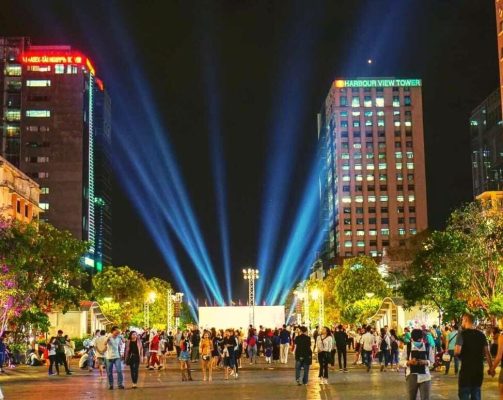
According to the ancients, at the end of the 20th century, this road every New Year was crowded with buyers and sellers of all kinds of brilliant and colorful flowers. Up to now, this street is no longer a place for trade and commerce but has become a flower street attracting thousands of tourists during Tet. This place is arranged and presented in the most elaborate way, arranging flowers, combining and pruning to create beautiful spaces, typical for each year. Becoming the Nguyen Hue flower road for everyone to travel in spring. Located right on Nguyen Hue pedestrian street itself, this place attracts many book-loving tourists. You can just go for a weekend stroll and get lost in the world of your favorite books. It was a comfortable, rewarding, and extremely comfortable trip. Nguyen Hue Walking Street is always an attractive destination for both Saigonese and tourists. As it always carries an unusual bustling attraction, many strange places to explore and intrigue. We hope you will find your own pedestrian street in your heart.
- Address: Nguyen Hue Pedestrian Street – Ben Thanh Ward – District 1
Saigon Central Post Office
Saigon Post Office Building is one of the famous architectural works of the city. Different from the bold French architecture above, Saigon Central Post Office has many features of European architectural style combined with Asia. The front of the post office is decorated with the names of some French celebrities such as Laplace, Voltaire, Arage, and some decorative squares in familiar shapes… On the arc of the house, there is a large clock. Stepping inside, guests see two high walls, two historical maps of Saigon, gothic architecture, and more than 35 customer service counters. Currently, this place also has souvenir stalls with handmade products imbued with Vietnamese identity.
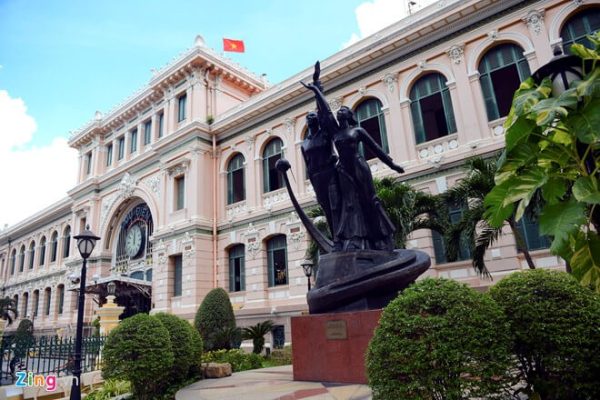
Located in the center of the city, the unique beauty of the city post office building is exalted. In front of it is the Notre Dame Cathedral with its soaring bell tower. Looking to the sides are modern high-rise buildings. This harmonious combination turns this place into a place that is both ancient and full of the breath of modern life.
Saigon Central Post Office is one of the typical architectural works of Ho Chi Minh City, located at 2 Paris Commune Square Street (Ben Nghe Ward, District 1). This is a building built by the French from 1886-1891 according to the design project of architect Villedieu and his assistant Foulhoux. The architecture is European style combined with Asian decoration.
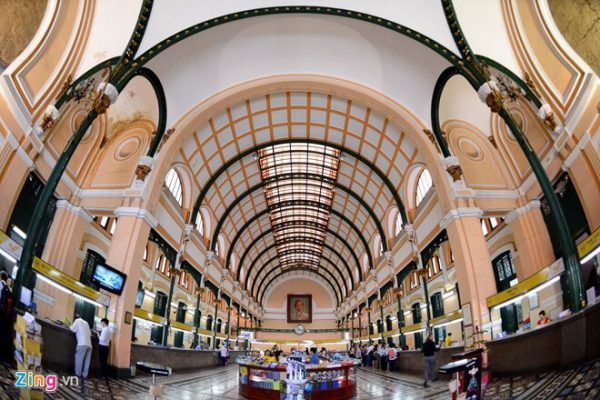
The most impressive feature when visiting inside the building is the large round arches at the entrance, along the ceiling. Inside the building is a system of arches close to the main door and long arches inside. The large arch is supported by four iron pillars located at the four corners, each supporting four iron trusses radiating to all four sides. On the dome in the foyer of the building are two historical maps. The right plate is a map of Saigon and its surroundings in 1892, and on the left is a map of the power lines of Vietnam and Cambodia in 1936. Outside, the front of the house is decorated with rectangular boxes, on which registrations are written. inventors of the telegraph and electricity. On the squares, there is a picture of a person wearing a laurel wreath, and a large clock. Below the clock is still kept the year of construction and inauguration of the building. The facade of the post office is decorated with the names of some French celebrities such as Laplace, Voltaire, Arage, and Gay-Lvssac.
Today, with the development of the internet, mobile phones, and other transportation services, Saigon Central Post Office is no longer as busy as before. Having existed in this land for 150 years, Saigon Central Post Office has witnessed countless ups and downs of history, and how many changes have taken place in the southern city of this country. Today, Saigon Post Office has become an indispensable tourist destination for tourists everywhere when visiting Ho Chi Minh City.
People come here, partly to see the unique architecture of this post office, to be immersed in a world of antiquity, from the mailbox to the phone booths. One can also rest on the varnished wooden benches, which are easily hundreds of years old. Stepping into the post office, it feels like time is moving very slowly, because, at any corner, you can catch a glimpse of old Saigon.
The Central Post Office is still operating normally to serve people with modern communication services in addition to many traditional services such as timed parcels, express delivery, cultural souvenirs, flowers, and electricity. phone…
- Address: 2 Paris Commune, Ben Nghe, District 1, Ho Chi Minh City
- Phone: 028 3822 1677
Bui Vien West Street
Saigon is famous for its many attractive tourist attractions. It is impossible to ignore Bui Vien West Street – a familiar entertainment place for all tourists and residents here.
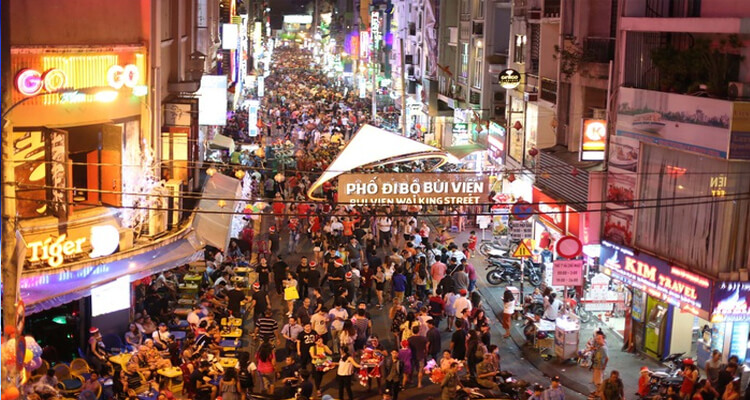
The famous street of Saigon is located in Pham Ngu Lao Ward, District 1, Ho Chi Minh City. West Street stretches along the streets of Bui Vien, De Tham, Pham Ngu Lao, and Do Quang Dau. The neighborhood has been in operation since August 2017 and has attracted a lot of attention from Saigonese and tourists from all over the world. Before 1975, this place was called “International Crossroads”. This name was originally not named on the map but was used to refer to the area of five streets around the workers’ theater. There are 5 streets: Bui Vien (Bao Ho Thoai), De Tham (Dismude), Do Quang Dau, Tran Hung Dao (Gallieni), Pham Ngu Lao (Colonel Grimaud). Western Street” was set up by people later. Because this place has a lot of Western tourists from all over the world gathered. Most are backpackers.
This street has long been extremely multicultural, and multinational with many Asian, European, and American tourists. This western street is open for people to travel and have fun on weekends with a lot of interesting entertainment activities. Visiting here, you will see a lot of interesting performances on the sidewalk or in the street. There are also folk games such as skipping rope, and playing umbrellas, which attract a lot of attention. Especially with foreign tourists. In addition, here you can also enjoy a lot of attractive music performances. From traditional to modern music performances are performed.
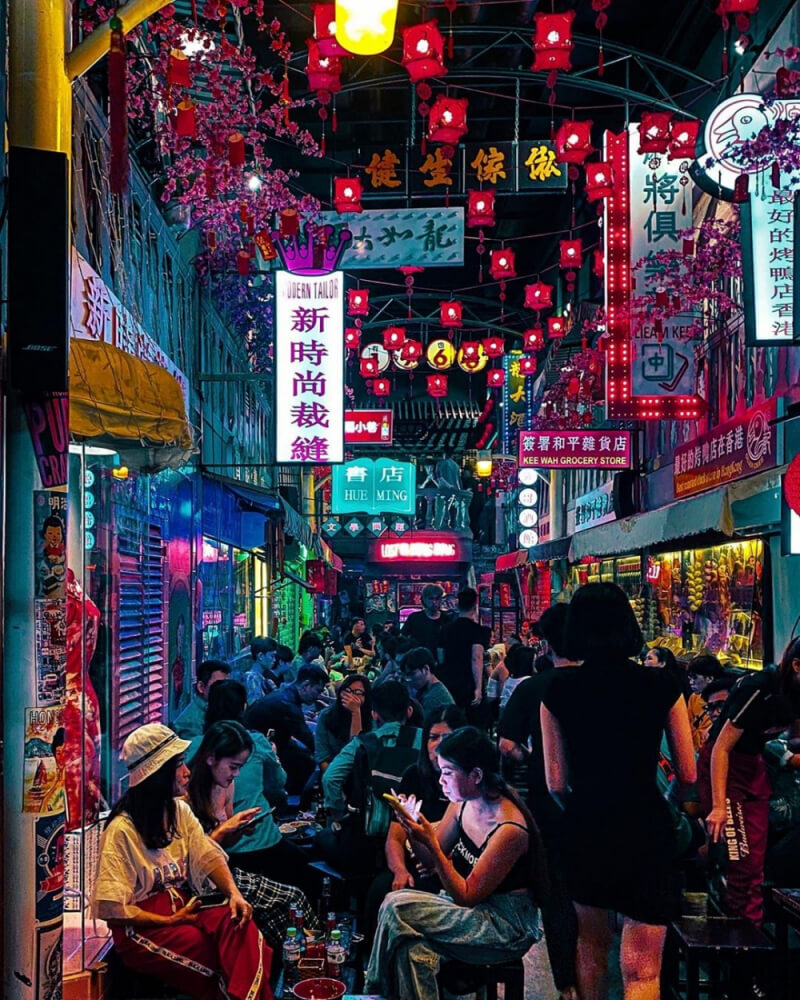
In the middle of this bustling and busy street, suddenly a swimming pool appeared. Right in the middle of the alleys close to the luxury hotels, there is a cool blue lake. Right here serves a lot of delicious dishes. This swimming pool belongs to the service system of Beautiful Sai Gon Hotel and The Oasis restaurant.
West Street is an extremely attractive tourist destination with many entertainment activities and delicious street foods. Let’s pack your bags and explore right away!
- Address: Pham Ngu Lao Ward, District 1
Related Article: A guide to Saigon travel experiences from A to Z
Above are the 6 most famous places to visit in District 1, Ho Chi Minh City that you can refer to to be able to make the most complete trip here. Vietnam Reviewer hopes that all of you will have a nice trip here. If you have any feedback or need help, please send an email to vietnamreviewer.contact@gmail.com!

